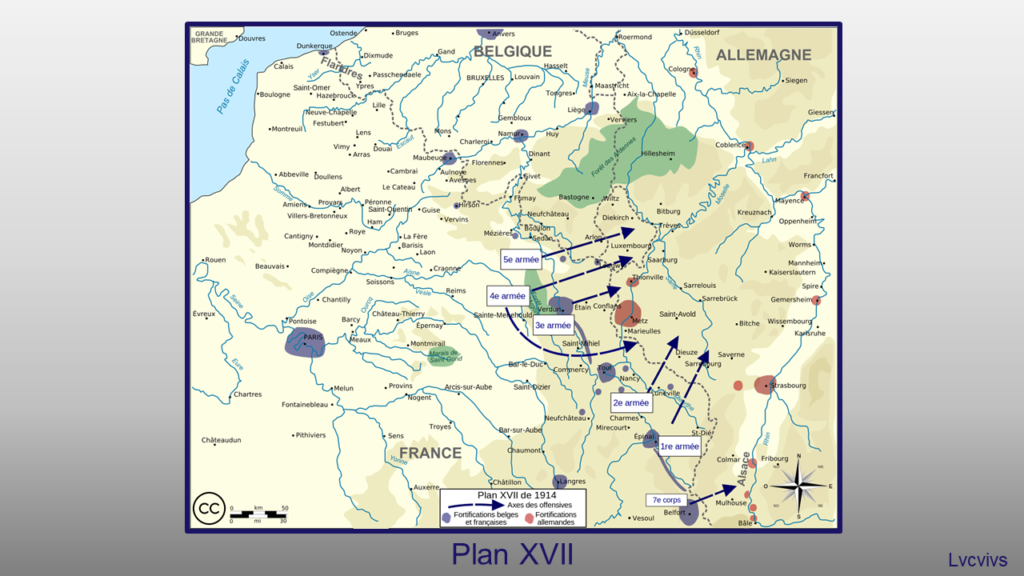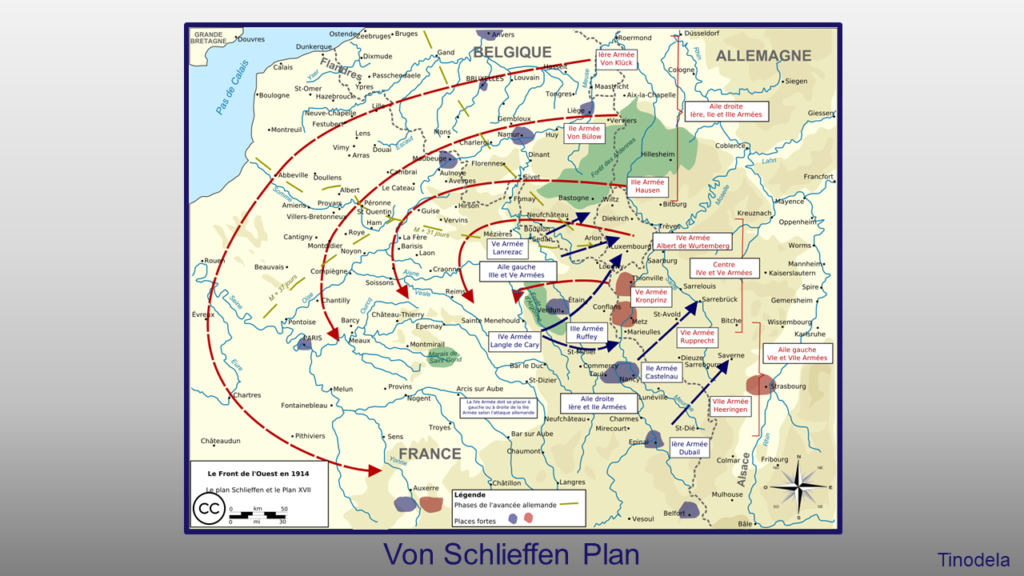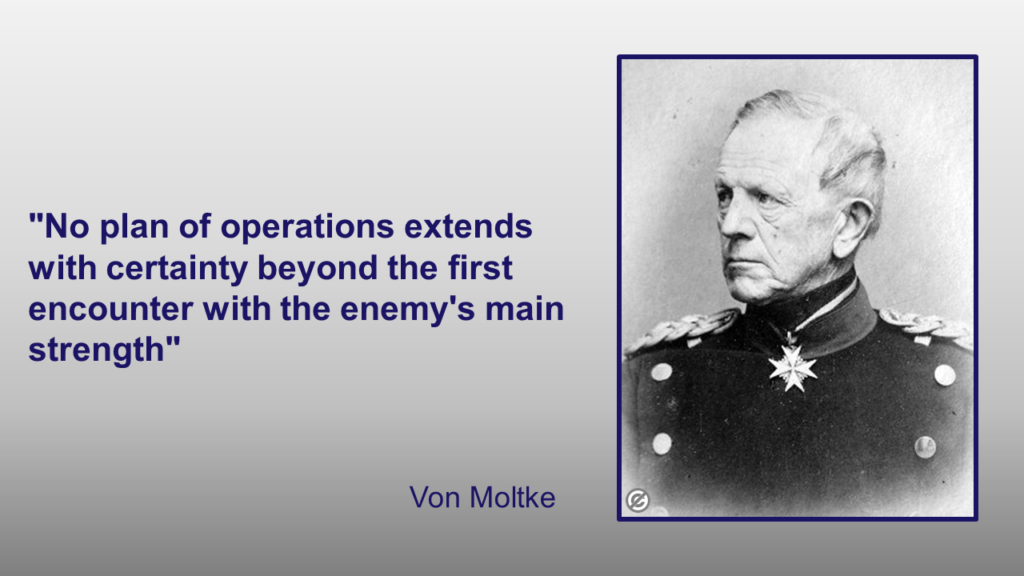Introduction
In the first two posts in the series we saw how the network of alliances and ententes failed to prevent the Great Powers coming to the brink of war. Then rigid adherence to mobilization plans accelerated events, preventing a pause, which would have given time to think. There was an undoubted willingness on all sides to avoid a general war. Given the pause the crisis could, like previous ones, have been defused.
Now that millions of men were on the march would these plans bring the hoped-for victory or prove another chimera?
I have a cunning Plan
All the Great Powers had indulged in some level of prewar planning, but it was France and Germany who had the most well-developed plans. It should be noted that these were “Military Plans” and were not necessarily shared with the civil authorities. No strong efforts were made to coordinate the Civil and Military planning, to form a coherent National Defense Strategy. (Although in the early 20th Century, it would have been more accurate to call it a National War Strategy)
- Plan XVII – France
- Von Schlieffen Plan – Germany
Both plans involved vigorous offensive action.

The French Plan XVII called for offensive along the common frontier, specifically in the Ardennes and into the lost territories of Alsace- Lorraine. Little regard was paid to a German attack through Belgium. No account was taken of the effectiveness of the machine gun in defence. With regards to artillery the French 75 was an excellent weapon, but there was little pre-war artillery/infantry coordination.

Von Schlieffen Plan
The von Schlieffen Plan (The Plan) was named after its author Alfred von Schlieffen, Chief of the German General Staff, from 1891 to 1906.
As mentioned in part 1, fear of “die einkreisung” (encirclement) was a constant worry for the German military, and the Plan was an attempt to address these concerns. This would be achieved by a massive strike against France, knocking Her out of the war in six weeks, before Russia could fully mobilize. An attack across the common frontier would necessitate the reduction of the French forts, which was beyond the current capability of German artillery, and was rejected. It was decided to fight a holding action along the common border, whilst the bulk of the army swung through Luxembourg and the tip if Belgium and into France. It should be noted that both countries were neutrals and there could be political repercussions for such a violation.
The Plan continued to be refined from the early 1890s until 1906 when von Schlieffen retired. With each subsequent iteration the size of the right wing and the degree of violation of Belgium increased until three Army Groups would “swing through Belgium.
In the words of the old proverb:
“Better hung for a sheep than a lamb” 1

The Plan had several problems:
- It was not clear if Belgium would fight (if it did there would be delays)
- The violation of Belgium neutrality could bring Britain into the war
- The German army did not have sufficient troops to execute the plan2
By August 1914, none of these problems had been solved and the questions were left unanswered, indeed von Moltke (the younger), compounded the problem of manpower, by weakening the right wing.
Britain
Unlike France and Germany, Britain had no compulsory military service, so did not have a large pool of trained manpower, and consequently had no grandiose plans.
Britain had available 6 infantry divisions and 1 cavalry. These were all composed of regular soldiers, Britain being the only Great Power to go to war with an all professional army.
There was a mobilization plan if Britain was required to come to the aid of France.
This called for the troops to be mobilized and transported to designated French ports within two weeks.
Britain’s main strength lay in Her Navy.
August 1914
As we saw in Part 2, August brought a flurry of mobilization and declarations of war
- 31st July Russia mobilizes
- 1st August Germany mobilizes and declares war on Russia
- 2nd August Germany demands free passage through neutral Belgium
- 3rd August Germany declares war on France
- 4th August Germany declares war on Belgium and invades
- 4th August Britain demands a German withdrawal from Belgium, and when the demand was not met declares war on Germany
As German troops moved into Belgium and Luxemburg on the 4th of August France prepared to launched Plan XVII.
The Belgians had decided to fight and had prepared bridges and railways for demolition, to hamper the German advance. The result of this was that the German timetable started to slip and when they encountered the Belgium forts with their defensive networks they were held-up for several days whilst the heavy siege artillery was brought-up and deployed. Once in place these super guns quickly demolished the forts which had cost thousands of lives in direct assault, on previous days.
Although the armies were moving again it was necessary to leave garrison troops, reducing the numbers available for combat operations.
During this period, the Germans committed atrocities, taking and executing civilian hostages and destroying villages for alleged partisan activity.
Meanwhile, the British Expeditionary Force (BEF), was mobilized and transported to France. Their deployment had gone according to plan, and they were now on the road to Belgium.
France executed Plan XVII with a series of offensives in the west between the 7th and the 18th of August, by which time the French had been driven back to their start points.
The attaque à outrance had proved no match for modern weapons, with tens of thousands of Frenchmen killed. Poor coordination between the artillery and infantry added to the disaster.
Joffre the French commander finally realized the danger to his left and started to move troops to face the threat, whilst others held the German left.
This sent the French Fifth Army and the BEF marching to Belgium.
Meanwhile the Germans were unclear whether the BEF had arrived, and if so where it was, until elements of von Kluck’s First Army ran into it at Mons, at the same time as Bülow’s Second Army clashed with Lanrezac’s Fifth French Army at Charleroi, on the 23rd .
There are many legends about Mons in British folklore, tales of angels appearing, etc.
But it was a clear defeat, although the German did suffer badly from the ten round SMLE (Short Magazine Lee Enfield), in the hands of regular infantry.
Both the BEF and the Fifth army were able to disengage and make a rapid retreat, before the superior German numbers could crush them.
With the Germans in hot pursuit the British “2 Corps” was forced to make a stand at Le Cateau but were again able to disengage and continue the retreat, before being trapped and destroyed.
“The Miracle of the Marne”
The retreat continued until the 5th of September when the allied armies made a stand on the Marne.
During this period, the commander of the BEF, Sir John French, who ironically did not speak much French and did not particularly like the people, got cold feet and was going to pull the BEF out of the line to refit. This was based on his interpretation of his orders to preserve the BEF in being.
It took a visit from the British, Secretary of State for War, Lord Kitchener to stiffen him and another from the French commander Joffre to basically beg him to keep the BEF in the fight.
Joffre may have been a reckless proponent of the attaque à outrance, but he was also extremely un-flappable. He kept his head where many others in a similar situation would have panicked.
He realigned his forces and then unleased them on the German juggernaut.
And between the 5th and the 12th of September the world witnessed what became known as “the Miracle of the Marne”. With troops rushed to the front in a convoy of Parisian taxi cabs, the Germans were turned back from Paris and retreated to defensive positions on the river Aisne.
The Race to the Sea
The German plan was a strategic retreat to a defensible line, before renewing the offensive and final victory.
Alas, it was not to be.
Joffre attacked, and when he found the enemy entrenched, attempted to outflank them instigating what became known as the “race to the sea”. The race ended around the 19th of October with neither side the winner.
Both armies now faced each other, on a line that would change little in the next four years, in a struggle that would cost the lives of millions and cause the fall of empires.
Conclusion
So how did that plan work for you?
The French Plan XVII and the doctrine of attaque à outrance, was a total failure.
Only by keeping a cool head and improvising was Joffre able to blunt the German advance. However, the French army still lacked the ability to defeat them in the short term.
Both the plan and the doctrine took no account of the advances in military technology, which had been shifting the balance in favour of defense for more than half a century.
The von Schlieffen Plan certainly came close to succeeding, and many have claimed that the failure was due to Moltke’s weakening of the right wing.
There were several other factors that we should consider:
- Its author believed the German army lacked the numbers to successfully implement the plan. (Nothing was done to change this and yet the plan was implemented)
- The initial French opposition was poor. (A plan cannot rely upon the enemy being stupid)
- The plan involved violation of Belgium neutrality. (Insufficient consideration was given to the difficulties that would arise from Belgium choosing to fight)
- Also, insufficient consideration was taken of the resources Britain and its Empire would bring to the Entente side. (Too much faith was placed on a quick conclusion of the war, before these resources could be brought to bear)
- Had France immediately moved to support Belgium the fight for Belgium would have been even harder. (The Germans were allowed unmolested to destroy the Belgium army)
Another factor that should be considered is the overall performance of the German army.
German soldiers, far from the often held belief that they were automata, in general showed more initiative than their opponents, and were more effective soldiers.
According to Col. T. N. Dupuy in his book “A Genius for War”, the Germans generally outperformed all their opponents in kill ratio. Niall Ferguson in his book “The Pity of War”, expands on this and contends that the Germans managed the superior kill ratio at a lower cost.
I appreciate that these are rather macabre statistics, but we are talking about a particularly horrific war.
In other words, they were more effective and efficient, so the near success may have had more to do with this than with the merits of the plan.
(Why they failed to win the war will have to wait for another time)
Ultimately there are many other factors which affected the outcome of the war, other than battlefield performance.
The participants had blundered into the war, with no real war aims. The horrendous casualty lists of the first two months of the war hardened attitudes and reinforced “sunk cost fallacies” on all sides, meaning that there could be no negotiated peace, condemning the world to four more years of carnage.
Top Lesson for Project Managers
I used the title of Norman Angell’s book, in this series title, because we often have the illusion that if we just plan every minute detail everything will work out.
If we allow ourselves to be seduced, Planning is the great illusion
.
That does not mean that we do not plan, as President Eisenhower said:
“In preparing for battle I have always found that plans are useless, but planning is indispensable”
Or as the hero of Germany’s Wars of Unification said:

What can we as project managers take from this tragedy?
- Remember a plan is just a … plan
- If things go wrong, keep your head and adapt then re-plan
- Just because a plan has been years in the making does not make it gospel
- Question your assumptions relating to the plan
- Are you wedded to old and obsolete doctrine?
- Do not make assumptions about how someone else will react, based on your perspective
- Do not become enmeshed in the “sunk cost fallacy”. Know when to terminate a project and cut your losses
- Finally, what would Darth Vader advise if he were a project manager?

A Personal Note
In a rare departure I would like to recount a family story, where WWI directly affected a family plan and is probably responsible for me being here.
In 1911 my great grandfather James R Benvie moved the entire family from Dundee, Scotland to Cincinnati, Ohio.
When WWI started and the call went out for volunteers my grandfather Alexander S Benvie returned to Scotland to enlist in the British Army.
He met my grandmother, who would not leave Scotland, so they raised a family in Scotland and I eventually came along.
I moved to Texas around 80 years later and met and married an Ohio girl.
How is that for coincidence?

One final note from Scotland’s national poet.

NOTES
1 This is from the old English proverb, meaning that once you had incurred the consequences for an action you may as well commit a bigger crime, and make the risk worthwhile.
2 Von Schlieffen is quoted by John Keegan, in his “An Illustrated History of the First World War”, as saying “we are too weak”. He estimated the Army would need to be expanded by the addition of 8 Army Corps, to successfully execute the plan.
3The English version is usually given in this form:
“The best-laid schemes of mice and men
Go often askew”
BIBLIOGRAPHY
- The Guns of August: Barbara Tuckman
- The War that Ended Peace: Margaret MacMillan
- The Pity of War: Niall Ferguson
- George, Nicholas and Wilhelm: Miranda Carter
- An Illustrated History of the
- First World War: John Keegan
- A Dictionary of Battles: Brigadier Peter Young
- A Genius for War: Col. T. N. Dupuy

Excellent article Jim. Loved the personal connection at the end!
Great article!
It is a pity that millions died during WW1 bloodshed
Thanks Daulen
Jim, I assumed that you were quoting the great Pvt Baldrick, batman for CAPT Blackadder in your title: “I have a cunning plan!”
Bob, Thanks for checking the blog.
It was indeed, just seemed the right quote.
Awesome – love Blackadder and Mr. Bean of course. He is probably a PMP as well…the one where he paints his flaw with a firecracker may have some lessons.
How do I get to Parts 1 & 2, I don’t see a link on the homepage.
Thanks
Hi Bob,
Sent you the links by e-mail
Sorry for the inconvenience
Much appreciate your interest in the blog
Thanks